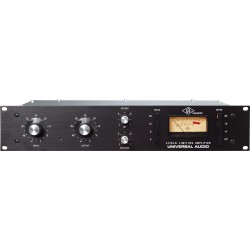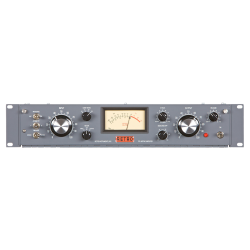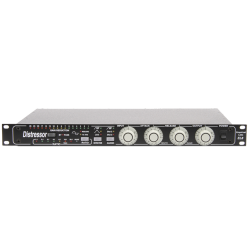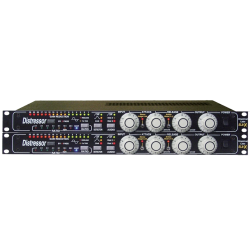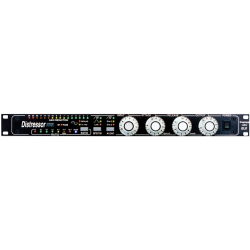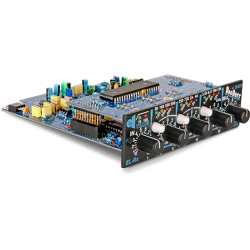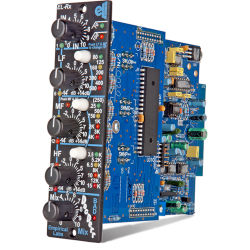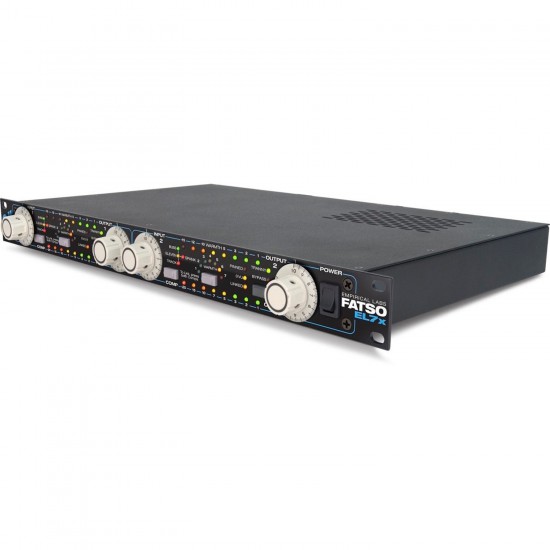
WHAT IS THE FATSO?(Hmm, Not such an easy question!)
The EL7 FATSO is a modern digitally controlled analog device that offers many of the “musical non-linearities” exhibited by the older tube, class A discrete, and magnetic tape mediums. This two channel audio processor will musically integrate frequencies and transients, increasing the apparent volume without actual increase in peak levels. In addition, two channels of famous Empirical Labs compression are provided. There are several compressor “types” with xed attacks and releases (if you want a fully controllable compressor, you will need the Empirical Labs Distressor!).
Users can enhance & soften the sound of digital mediums such as DAWs, Hard Disk Recorders, CD players, MP3s etc. Mixdown engineers will have an option not to use bulky, expensive, (and often aky) analog tape recorders to get the warmth and sweet high end they’ve come to rely on for so many decades. Owners of modern digital recorders can nally put a stop to complaints about the “coldness” and “brittle edge” of their mixes and instruments with the “rounded” and “musically non-linear elements” of vintage analog. Audiophiles can bring back the warmth and cuddly sound of LP’s and tapes to their digital audio mediums.
FATSO’S FOUR TYPES OF PROCESSING
2) HIGH FREQUENCY SATURATION - WARMTH! - This circuit is meant to simulate the softening of the high end that occurs with analog tape. Basically as the warmth is increased, overly bright signals and transients will be quickly attenuated. The time constants are nearly instant, so the high freqs return very quickly after a loud, brittle burst.
4) CLASSIC KNEE COMPRESSION - Empirical Labs Style. This is your automatic leveling device that you nd used on just about every modern instrument and vocal track, as well as on the overall buss. And it’s Empirical Labs Compression - smooth, warm and in your face. See the compression guide on page 11 for description of the 4 compressor types.
USING THE FATSO FOR THE FIRST TIME
Hookup is straightforward. Either the XLR’s or phone jacks can be used. In relation to the phone jack tips, pin 2 is wired “hot” on the XLR’s. But if you’re using the XLR’s in and out, it doesn’t matter which pin is hot, as long as you’re cabling is in phase. If you use a single ended XLR output, leave unused pin oating! Connecting all input pins is preferred, but the unit will operate ne if unused Input pins aren’t tied to ground. Hookup directions are also located on the rear panel of unit, near the connectors. See page 14 for more detailed wiring instructions.
It’s advisable to mount in a cool rack position, as the FATSO can run quite warm. FATSO is ideal for sources that sound brittle, bright, or pointy or have excessive dynamic range. You will probably nd so many uses for the FATSO as we did, but ...let’s just go over a couple quick scenarios here. Let’s say you have a vocal either live or in the studio that seems lifeless or needs presence and intensity. First lets set the compressor up. In fact you should always set the compressor up rst because it interacts with the other processors in the FATSO.
For excessively dynamic vocals I would go right to the TRACKING compressor with the Red LED lit in the compressor select area. The ELEVEN is also excellent, but a bit more aggressive than the TRACKING compressor. Adjust the input til you get 5 dB of GR to start with and adjust the output knob until there’s not a great difference between the bypassed and un-bypassed levels. The Bypass switch is multiplexed and to cycle bypass, click twice quickly on older units, or hold button for 1 second on new units to cycle backwards. Next decide if the vocal has a brittle edge on the top end. If so, you have two other ways to soften. The most subtle is the TRANNY which engages a specially tweeked transformer circuit that enhances the midrange while softening extreme transients and fattens 200 hz and below. That may not be what one needs on vocals though.
- Stock: In Stock
- Model: EL7-X FATSO


